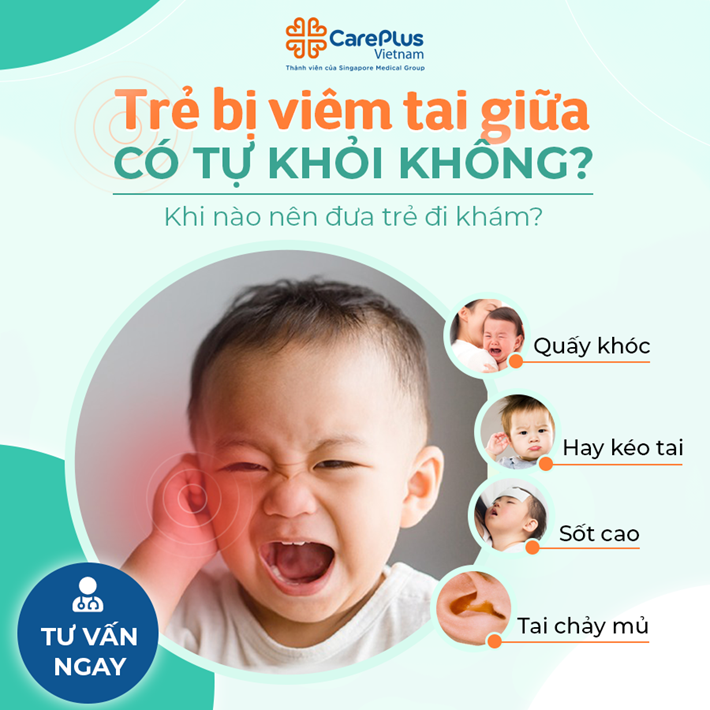Ear Infections (Otitis Media) - Signs and Treatment
Ear infections or Otitis Media happen when viruses or bacteria enter the middle ear, the space behind the eardrum. When a child has an ear infection, the middle ear fills with pus (infected fluid). The pus pushes on the eardrum, which can be very painful.

7/27/2023 9:55:30 AM
What Are Otitis Media?
Ear infections or Otitis Media happen when viruses or bacteria enter the middle ear, the space behind the eardrum. When a child has an ear infection, the middle ear fills with pus (infected fluid). The pus pushes on the eardrum, which can be very painful.
What Are the Signs & Symptoms of an Ear Infection?
Ear pain is the main sign of an ear infection. Kids also might have:
-
A fever
-
Eating, drinking, or sleeping problem
-
Painful pressure in the ear when chewing, sucking, and lying down
Older kids can complain about ear pain, but a younger child might tug at the ear or be fussy and cry more than usual.
If the pressure from the fluid buildup gets high enough, it can rupture the eardrum, with fluid draining from the ear. This is a common cause of ruptured eardrums in children. A child with a ruptured eardrum might feel dizzy or nauseous and have ringing or buzzing in the ear.
How Do Ear Infections Happen?
A middle ear infection usually happens because of swelling in one or both of the eustachian tubes (which connect the middle ear to the back of the throat). The tubes let mucus drain from the middle ear into the throat.
A cold, throat infection, acid reflux, or allergies can swell the eustachian tubes. This blocks the mucus from draining. Then, viruses or bacteria grow in the mucus and make pus, which builds up in the middle ear.
When doctors refer to an ear infection, they usually mean otitis media rather than a swimmer's ear (or otitis externa). Otitis media with effusion is when noninfected fluid builds up in the ear. It might not cause symptoms, but in some kids, the fluid creates a sensation of ear fullness or "popping."
Why Do Kids Get Ear Infections?
Kids (especially in the first 2 to 4 years of life) get ear infections more than adults do for several reasons:
-
Their shorter, more horizontal eustachian tubes let bacteria and viruses find their way into the middle ear more easily. The tubes are also narrower, so more likely to get blocked.
-
Their adenoids, gland-like structures behind the nose, are larger and can interfere with the opening of the eustachian tubes.
Other things that can put kids at risk include secondhand smoking, bottle-feeding, and being around other kids in childcare. Ear infections are more common in boys than girls.
Ear infections are not contagious, but the colds that sometimes cause them can be. Infections are common during winter weather when many people get upper respiratory tract infections or colds (a child with an ear infection also might have cold symptoms, like a runny or stuffy nose or a cough).
How Long Do Ear Infections Last?
Ear infections often cure themselves within 2 or 3 days, even without specific treatment.
Fluid in the middle ear often, even after an infection clears up. More treatment might be needed if it's there for longer than three months.
How Are Ear Infections Diagnosed?
Doctors will do a physical exam and examine the ear. They use an otoscope, a small instrument similar to a flashlight, to see the eardrum.
How Are Ear Infections Treated?
To treat an ear infection, healthcare providers consider many things, including:
-
the type and severity of the ear infection
-
how often the child has ear infections
-
how long this infection has lasted
-
the child's age and any risk factors
-
whether the condition affects hearing
The type of otitis affects treatment options. Not all kinds need to be treated with antibiotics. Because most ear infections can clear independently, many doctors take a "wait-and-see" approach. Kids will get medicine for pain relief without antibiotics for a few days to see if the infection improves.
Antibiotics aren't routinely prescribed because they:
-
won't help an infection caused by a virus
-
won't get rid of middle ear fluid
-
can cause side effects
-
usually don't relieve pain in the first 24 hours and have only a minimal impact after that
Also, overuse of antibiotics can lead to antibiotic-resistant bacteria, which are much harder to treat.
If a doctor does prescribe antibiotics, a 10-day course is usually recommended. Kids from 6 and older who don't have a severe infection might take a shorter period for 5–7 days. If the infected ear is draining, antibiotic ear drops may be used as well.
Some children, such as those who get ear infections a lot and those with lasting hearing loss or speech delay, may need ear tube surgery. An ear, nose, and throat (ENT) doctor will surgically insert tubes (called tympanostomy tubes) that let the fluid drain from the middle ear. This helps equalize the pressure in the ear.
When Are Antibiotics Needed?
Antibiotics can be the proper treatment for kids who get a lot of ear infections. Younger children or those with more severe illnesses may need antibiotics right from the start.
The "wait-and-see" approach also might not apply to children with other concerns, such as cochlear implants, cleft palate, genetic conditions such as Down syndrome, or other illnesses such as immune system disorders.